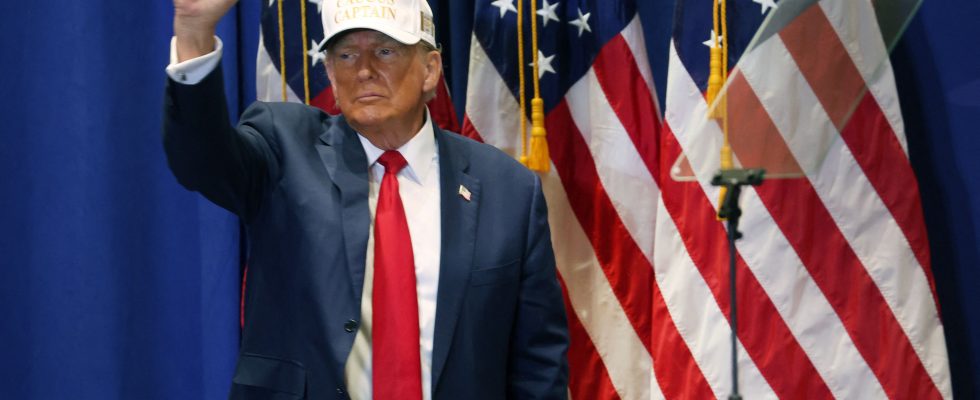American presidential election: great start! This Monday, Republican voters in Iowa, a small state of 3 million inhabitants, are called to the polls for the first caucus of the United States electoral campaign. This vote, eleven months before the final vote on November 5, constitutes the first step in a long process.
For the moment, no candidate – even if there is little suspense over the future nominees – is officially invested. Each state must, in advance, organize primaries or caucuses to elect delegates who, in turn, will choose their candidate.
The caucuses method
This Monday, January 15, Republican voters in Iowa will gather in schools, churches or pubs to choose former US President Donald Trump, Florida Governor Ron DeSantis or the former ambassador to UN, Nikki Halley, will represent them in the race for the White House.
On the Democratic side – and for the first time in fifty years – this small state will not open the primaries. Democratic voters in Iowa will have the opportunity to vote by mail between January 15 and February 19, then live in March. A change in calendar desired by Joe Biden himself. As a reminder, the current president failed in Iowa during the last election in 2020.
A vestige of participatory democracy, the caucus method is used in certain States to elect delegates (called “delegates”, across the Atlantic) from certain parties. The term refers to a neighborhood political meeting where a small number of members or elected officials come together and vote for their favorite candidate for the White House. In a state like Iowa, more than 1,600 such meetings will be held.
Although this method is less and less practiced due to its complexity, six other states will organize Republican caucuses: Wyoming, North Dakota, Idaho, Missouri, Kentucky and Hawaii. The Democratic Party is organizing caucuses in North Dakota, Wyoming and Idaho.
The organization of the primaries
States that do not practice the caucus method hold primaries to elect Democratic and Republican delegates. The premiere will take place in New Hampshire on January 23.
Joe Biden has already warned that he will not run in this state to favor South Carolina, where the Democratic primary will take place on February 3. For good reason, this state is dominated by a large African-American community, more favorable to the president in place.
In the United States, a federal country, each state has its own electoral law and organizes primaries as it sees fit. Some, like Georgia, have open primaries in which voters unaffiliated with their party can vote. Other states, such as Florida, prefer closed primaries – reserved for Americans registered as party voters – or semi-open.
“Super Tuesday”, the busiest Tuesday of the year
As the name suggests, “Super Tuesday” takes place on a Tuesday – March 5, for this year. With both parties holding their primaries and caucuses in 14 states simultaneously: Alabama, Arkansas, California, Colorado, Maine, Massachusetts, Minnesota, North Carolina, Oklahoma, Tennessee, Texas, Utah, Vermont and Virginia.
This same Tuesday will also take place the Republican primary in Alaska, as well as the Democratic caucuses in Samoa and Iowa.
In the Republican camp, no less than 874 delegates will be at stake. Thus, this massive vote allows us to have a more precise idea of the favorite for victory. The last presidential primaries will take place on June 4.
Allocation of delegates
States and parties have different rules for defining the number of delegates allocated to candidates, depending on their results in primaries and caucuses. For example, in the Republican camp, some states opt for proportional representation or the principle of “Winner take all”, allowing the leading candidate to obtain all of the state’s delegates. for the party.
Among Democrats, a standardized rule applies in all states. Candidates having obtained at least 15% of the votes share the delegates proportionally.
The nomination of candidates
Once the caucuses and primaries are over, Republican and Democratic delegates nominate their party’s candidate at major national conventions. To be invested, a candidate must gather a majority of delegates.
The Democratic National Convention will be held from the 19th to the 22nd in Chicago, Illinois, and will be attended by approximately 4,600 delegates. The Republican Party will take place July 15-18 in Milwaukee, Wisconsin. Some 2,400 delegates will be expected there.
According to the polls – and without much surprise – Joe Biden is far ahead of his competitors for the Democratic primaries. On January 9, he received 71.3% of voting intentions, compared to 6.1% for Marianne Williamson and 2.9% for Dean Phillips, according to the site FiveThirtyEight.com.
On the Republican side, Donald Trump remains well ahead, with more than 50% of voting intentions since April, again according to FiveThirtyEight. On January 10, he received 61.3% of voting intentions, compared to 12.5% for Ron DeSantis and 11.5% for Nikki Haley.
The final vote
November 5th is the big day. The American presidential election takes place by indirect universal suffrage in one round. State by state, tens of millions of Americans vote to elect 538 electors, who in turn designate the president.
These electors constitute an electoral college distributed pro rata to the populations of the States. For example, California, the most populous, has 54 while Wyoming has only 3. Nebraska and Maine are exceptions because the electors are allocated proportionally.
The candidate who wins the majority of votes wins all the major voters in the state, according to the “Winner take all” rule. To win the election, he must win an absolute majority of the electors – or 270.
If the vote takes place in November, the future president (in the event that Joe Biden is not re-elected) will not take office until three months later, at the end of January, to respect a transition period.
This same November 5, the legislative and senatorial elections will also take place. A third of the Senate and the entire House of Representatives will be renewed.
